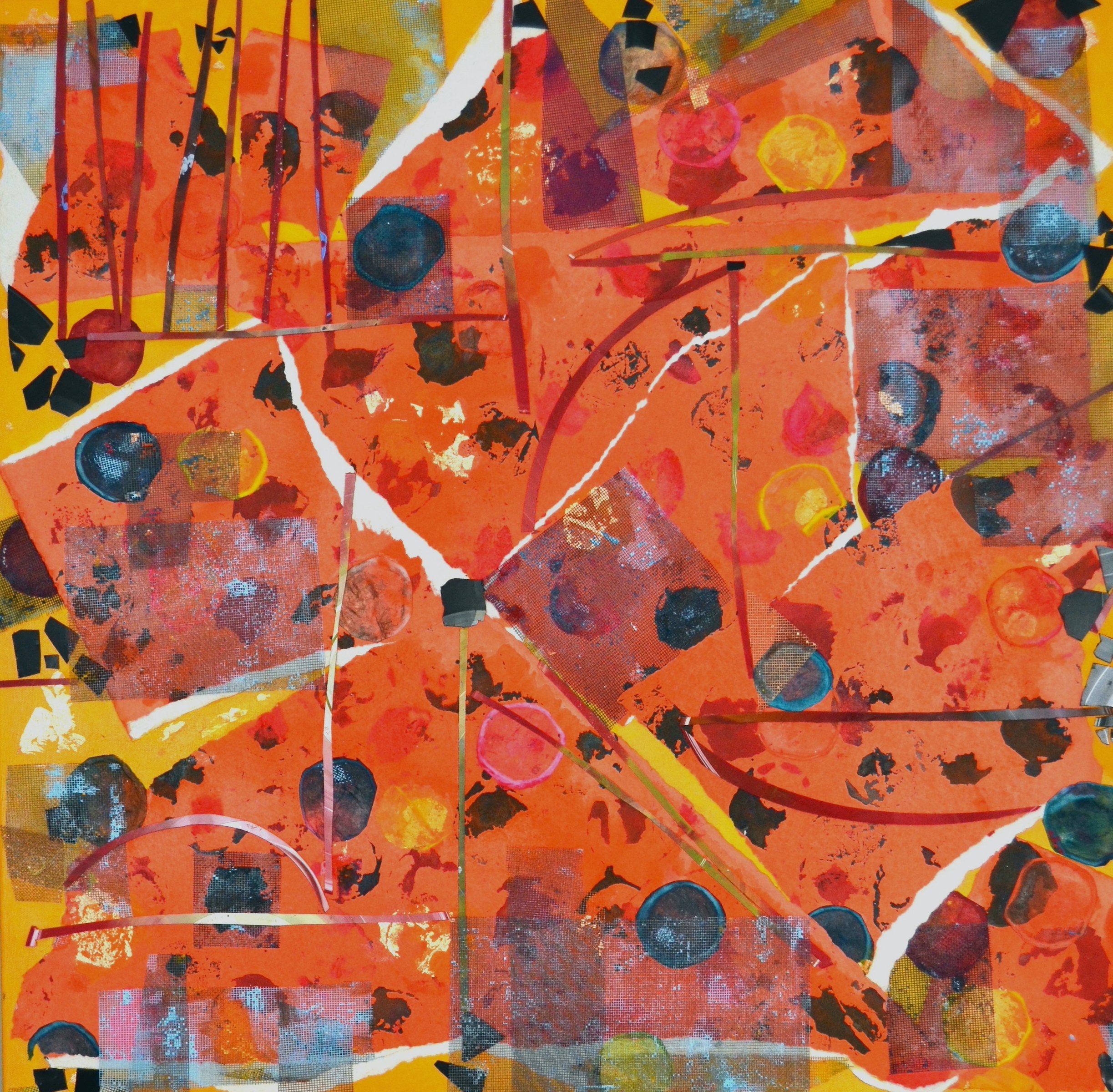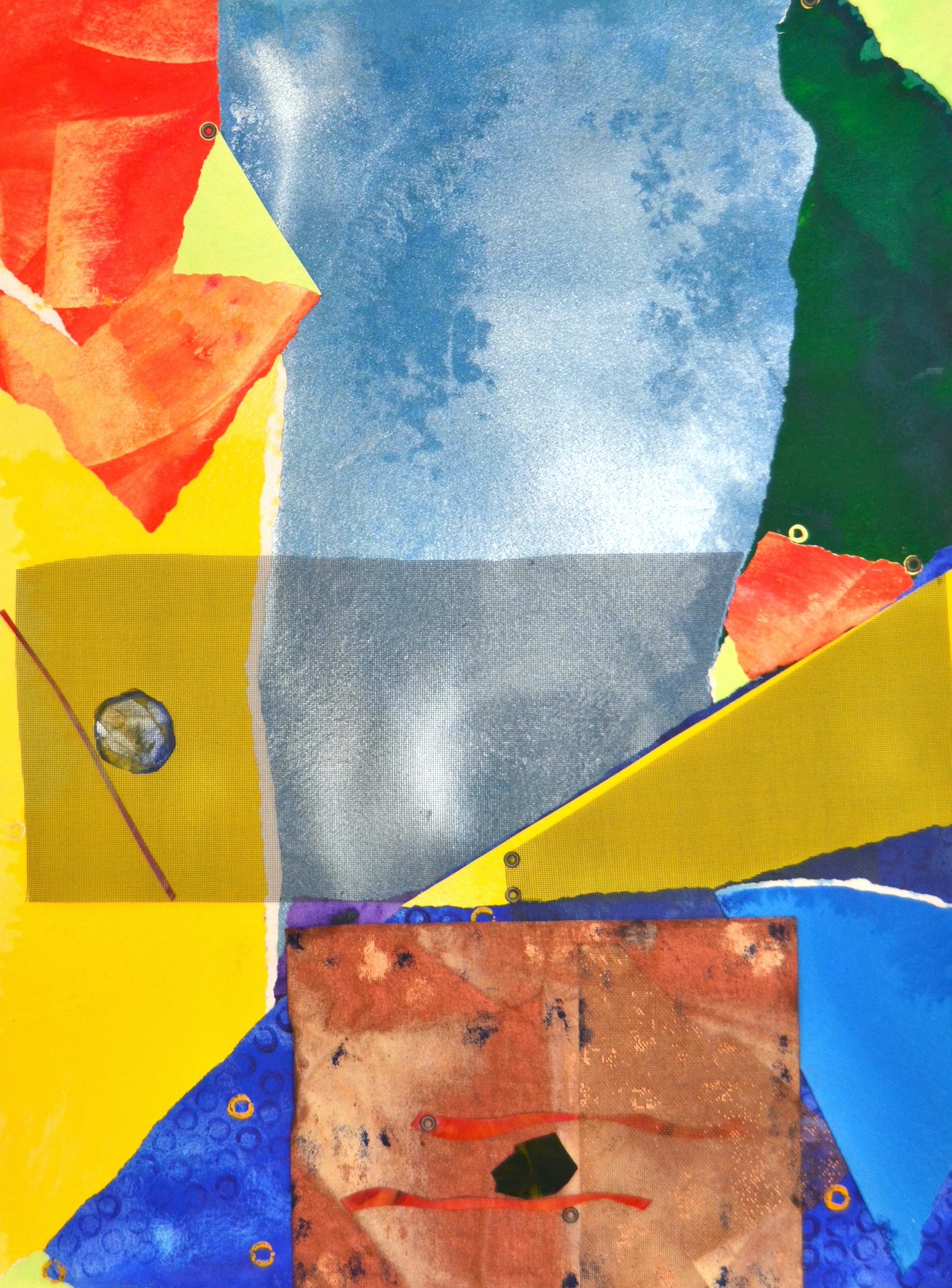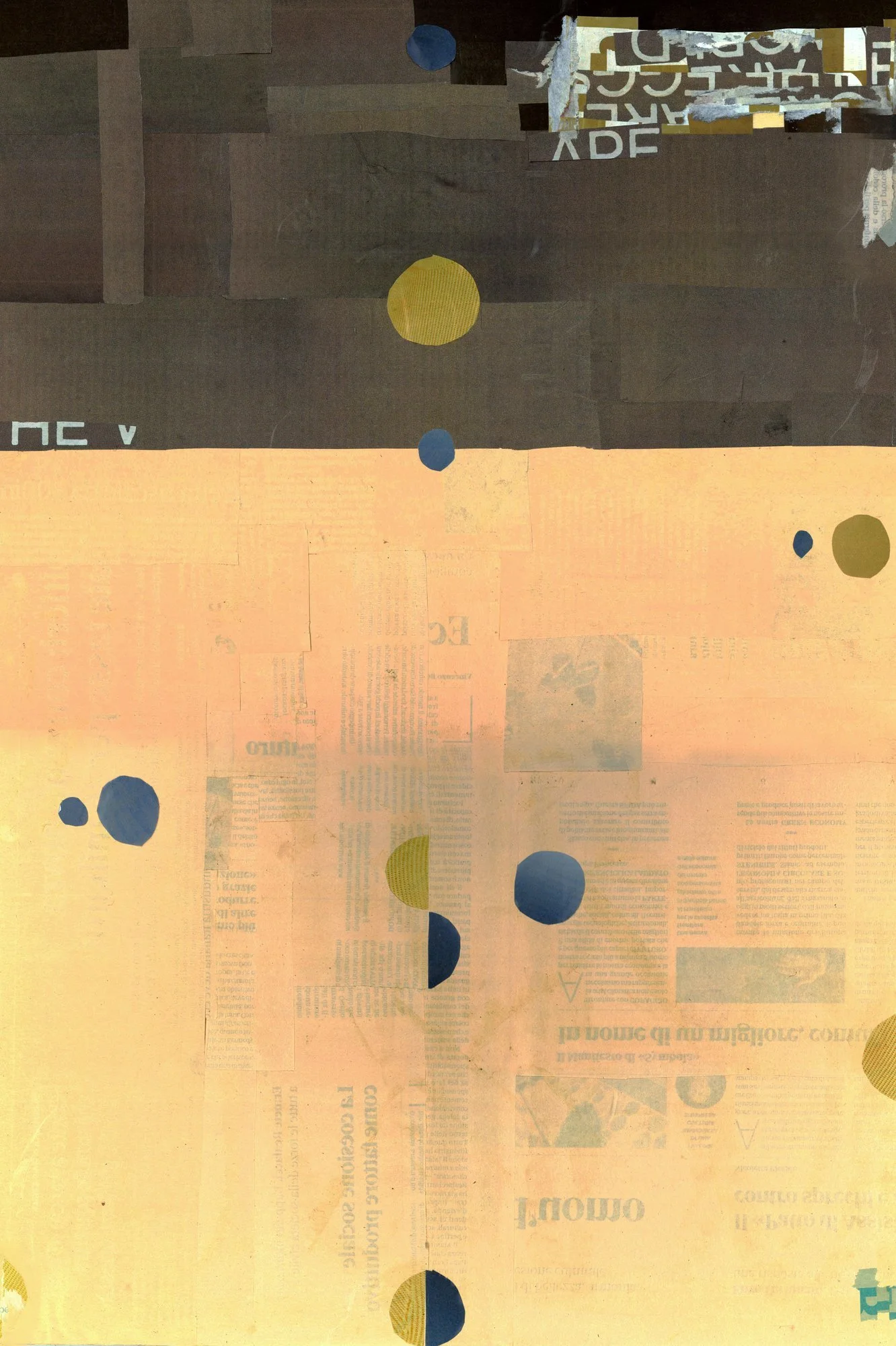10 Questions with Acquaetta Williams
Acquaetta Williams - Portrait
Acquaetta Williams’s art has been a journey from glassblower to sculptor and now a painter. She utilizes the feelings, thoughts, and memories inspired by African images to express their relevance to contemporary African American women. She tells a story in assemblages of materials contained in Giraffe Neck Women, Women Who Carry, followed by Deconstructing Time, Memories, Street Musician, and now Faceless Melodies. Her love for art was cemented under instructor and well know glass artist Harvey Littleton at the University of Wisconsin, where she received her MFA degree. She was awarded an Arts International Travel Grant to travel through Benin, West Africa. She has exhibited her art nationally in Uncommon Beauty in Common Objects: The Legacy of African American Craft Art, which toured five major museums throughout the United States. She has exhibited internationally at The International Glass Exhibition in Kanazawa, Japan, and "Color 2018" at the Czong Institute for Contemporary Art, Gyeonggi, Korea. Her work as a glassblower has been acknowledged in the permanent collections of Corning Museum of Glass in Corning, NY; the Museum of Arts and Design in NYC; Racine Art Museum in Wisconsin; and the National Afro-American Museum and Cultural Center in Wilberforce, OH.
“Why Do I Create Art? To remind people of their humanity”
ARTIST STATEMENT
Throughout Acquaetta Williams’ art journey, she has worked in a variety of mediums, including acrylic paint, glass, paper, canvas, and wood. The materials are diverse, addressing the surface and the depths of each form and connecting them to the stories that emerge from these environments. Stories that are about identity, love, compassion, anger, and sensitivity - all aspects of being human.
Williams’ art is an assemblage of repurposed materials, as seen in her series titled Deconstruction Memories. This work utilizes roller skates, pocket watches, camera lenses, and clarinets to create fragmented compositions of expressive and lyrical movement. Explosions of energy counter the rigid stability of a rectangular space, establishing bold and shifting perspectives that offer more to be discovered.
She creates a canvas surface like that of an aged, worn plaster wall using layers of repeatedly glued posters torn and weathered from sun, wind, and rain, peeling away and exposed. This is the starting point of her process. This wall is obscured and hidden from the viewer with the intention of adding mystery and curiosity. Williams exposes the energy, richness, and passion of the ‘Faceless’.
The collage paintings are made of diagonal, horizontal, and vertical lines. Moon-shaped eclipses rotate counter-clockwise, woven together with worn, scribbled messages that keep the eye constantly moving. The reflective energy of vinyl creates the illusion of shapeshifting through the tiniest of light moving and flickering, refusing to settle down. The vinyl pulls the canvas away from the wall, at the same time drawing the viewer in.
Williams manipulates the paper to increase density, volume, and texture. Her process of repetition seems to complement the geometry of the work, offering the viewer to contemplate the juxtaposition of something meditative and aggressive all at once.
Faceless Melodies embody the street musician, the religious fanatic, and the homeless. Their voices echo emotional agitation and sensitivity, often through music. Balanced, repetitive curves reveal more physical form, gritty texture, and sharp, bold color while speaking to us with compassion and love. Layered surfaces unzip and gently peel away, revealing the spiritual transformation — the heart and determination of individuals who have become invisible.
Nothing to Go Back To, acrylic, paper, vinyl, mesh, screen, 30x30 in, 2022 © Acquaetta Williams
INTERVIEW
First of all, tell us about your background. When did you start getting involved with visual arts, and how?
I grew up in Los Angeles, California, the only girl of five brothers in an African American family. After high school, my parents offered my brothers the military and, for me, the local community college. I loved music and enjoyed piano classes, even though there was no piano at home for me to practice on. There were also no conversations about what I wanted to do in life. The college offered basic still-life painting classes, which I enjoyed. I also took tennis lessons on the weekends, which helped motivate me to be active. After a year and a half at the community college, I was able to transfer to the University of California, Los Angeles (UCLA) due to an opportunity designed specifically for African Americans to enroll. I had intended to be a fashion designer. However, I enjoyed the many visual art challenges, especially glassblowing.
Beautiful Return, acrylic, paper, mesh screen, 30x30 in, 2022 © Acquaetta Williams
In fact, you started as a glassblower before turning to sculpture and painting. What inspired you to pursue a career in the art field?
My parents weren’t necessarily trying to encourage me to be an artist but more to experience the world around me. My first memorable introduction to art was a visit to the Watts Towers in Los Angeles, California. The Watts Towers are a hand-built monumental outdoor sculpture designed and created by Italian immigrant Sabato Rodia, who came to the United States in the late 19th century as a construction worker and tile mason. I loved the strength of the structure and the surprising kaleidoscope of colors, textures, glass shards, and rocks throughout the art. It was beautiful and full of good energy.
Another inspiring experience for me was when I attended an opening reception for an exhibition by Robert Rauschenberg. The exhibition featured his “white painting series,” which were simple geometric lines and shapes that created shadows, enhancing the overall presence of the work. I loved it. That was my first art opening. The gallery served only one drink, vodka tonics - there are these kinds of memories that never leave me. After that, I did an all-white collage series in 2017.
There are now countless museums that I am inspired by. The Natural History Museum, the Los Angeles County Museum, and the La Brea tar pits. I left California, thinking that I’ll be a designer.
After I attended the University of Wisconsin, Madison, I was also inspired by the few words that artist and instructor, Harvey Littleton, had impressed upon me, “Art classes were for people who wanted to be an artist.” Now I wanted to be an artist.
How would you define yourself as an artist nowadays, and what is your personal aim?
I see a need to further develop my collage paintings and expand the textural richness and the lush colors that I want to flow across the canvas. I’m deeply committed to expressing, through my art, the emotions and imagery that reflect the cultural diversity in our society. I’m willing to change everything to be an artist. I want my mind to be free to start a new project to discover new directions. Life’s struggles can slow you down or veer you off-course, but I have championed through them, and I have come out stronger on the other side with the freedom to think and paint as I please. I want to explore new creative possibilities and strengthen my communication skills through collaboration with others while further evolving my processes through assemblages of new techniques and materials.
Deconstruction Time Memories, blowglass, clarinet, rollskate, pocket watch, steel, 23x9x5 in, 2008 © Acquaetta Williams
Deconstruction Time Memories II, blowglass, clarinet, pocket watch, steel, 23x9x5 in, 2008 © Acquaetta Williams
Your works are often assemblage/collages, as you use different objects or images to create them. How do you choose the pieces to incorporate in your work? And what do they represent for you?
I was watching a popular game show called Jeopardy on television one night, and one of the answers was the word pareidolia. Pareidolia is the ability to see faces within patterns and images in everyday objects. I don’t know why or how this phenomenon occurs, but this is something that aptly describes how I process the world around me.
I love natural materials, aluminum, for its metallic sheen. Glass, for its light and translucence. Steel and copper, for their corrosive properties. Moreover, for the colors, the corrosion creates such as cool blueish, greens, the patinas of reds, oranges, and browns which are formed from exposure to air and water. I embrace with love and respect the need to be surrounded by nature, which calls out to us all.
How did you come up with this concept? And what messages do you want to convey?
The collages convey, for me, the human spirit. They embody an emotional agitation and sensitivity that I am constantly asking, ‘Who are those who orchestrate this music?’. The series “I am homeless” are faceless, vulnerable, and fragile. These urban dwellers have only the repetitive voice of a broken record. My intentions are directed towards deconstructing time through objects associated with a personal memory that is associated with the faceless, vulnerable, and fragile of this society.
Exhaling, acrylic, paper, vinyl, mesh screen, 30x40 in, 2022 © Acquaetta Williams
Follow Me, acrylic, paper, vinyl, mesh screen, 30x40 in, 2022 © Acquaetta Williams
You work with several different mediums, including acrylic paint, glass, paper, canvas, and wood, as you explain in your statement. But what is your favorite one?
Good memories have a way of never leaving you, and they are so energizing. Glassblowing is magical in its tingly sensation when you are blowing glass. When the sunlight diffuses, the intensity of the orange glow ball that floats through the air as the heat waves ripple off the molten glass, leaving myself and others mesmerized.
What is the one you find closer to your practice?
I think the collage paintings reflect more of who I am today. It encompasses everything that I love, and there is more of me to be discovered. I have gained an uncommon understanding of the innumerable creative and artistic possibilities and the ability to tell one story about the poor and marginalized, which reveals my empathetic nature as an artist.
You have exhibited extensively and internationally. How do you promote your work? And what do you think about the art community and market?
I have an online presence through my website, acquaetta.com; Instagram; Artsy; Albe Gallery in Dubai and Art In Embassy in Washington, D.C., where I have a piece of art on loan, at the Embassy of Burkina Faso.
As art communities around the world experience a time of challenge and change, galleries and museums are taking steps to open their doors and hear from artistic voices that never had an outlet. This provides an opportunity for cross-cultural communication and enhances the local, regional and international exchange of ideas. It encourages young artists to emerge and actualize their creative trajectories.
There is an interweaving between curators, galleries, critics, art collectors, and artists. I had never heard of Michael L, and Ann Brody, who donated their art collection to the Racine Art Museum, included in that collection were one abstract glass vessel and two a piece from my Giraffe Neck series. “Focus On Glass,” an article reviewed by Shepherd Express newspaper, celebrated four unique artists from four diverse backgrounds who have pushed the envelope. The critic wrote an excellent article highlighting my style and techniques. I was thrilled. Since the arrival of my art, RAM, has showcase my art in 4 different venues.
Nothing More, acrylic, paper, vinyl, mesh screen, 30x40 in, 2022 © Acquaetta Williams
Is there anything else you would like to achieve career-wise? Do you have any project you have been meaning to start?
I would like to rediscover my love of paper. Paper offers distinctive details and complements my geometric sense of balance. It adds a juxtaposition between meditative and aggressive, and I would like to develop this relationship more through the use of paper in ways that are architectural and organic.
Finally, where can our readers find your works next? Do you have any upcoming exhibitions or publications?
The Racine Art Museum in Wisconsin; The Montpelier Arts Center in Laurel, Maryland; Chicago Urban Art Retreat in Chicago, Illinois and the Lowes Building at the Capitol in Annapolis, Maryland. My work currently appears in the magazine Colours, Issue No 12 Special Edition, September 2022.























